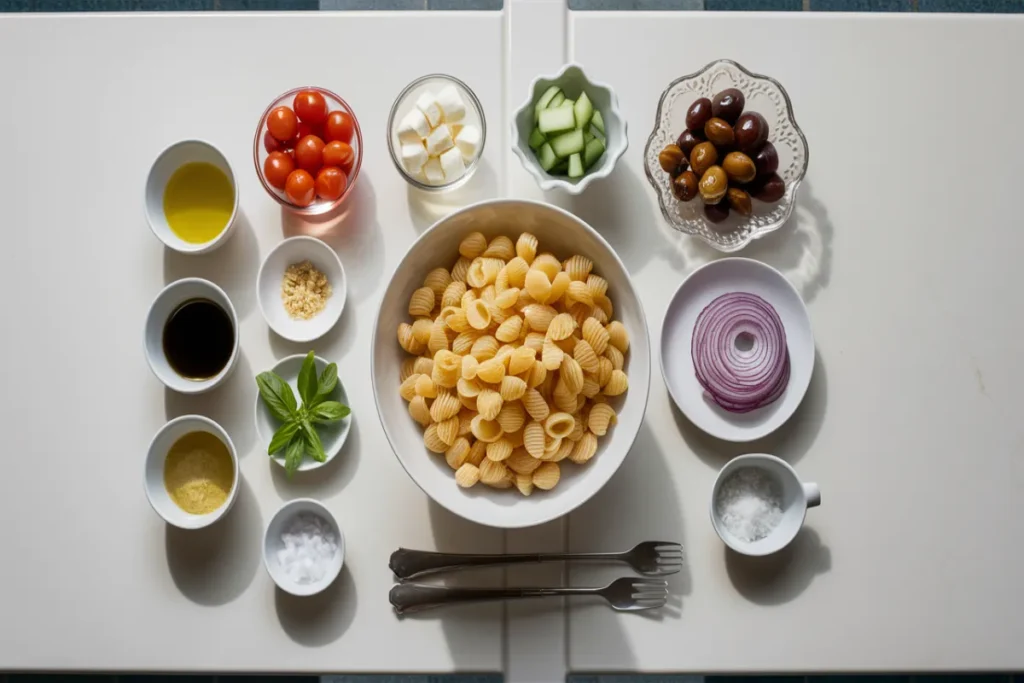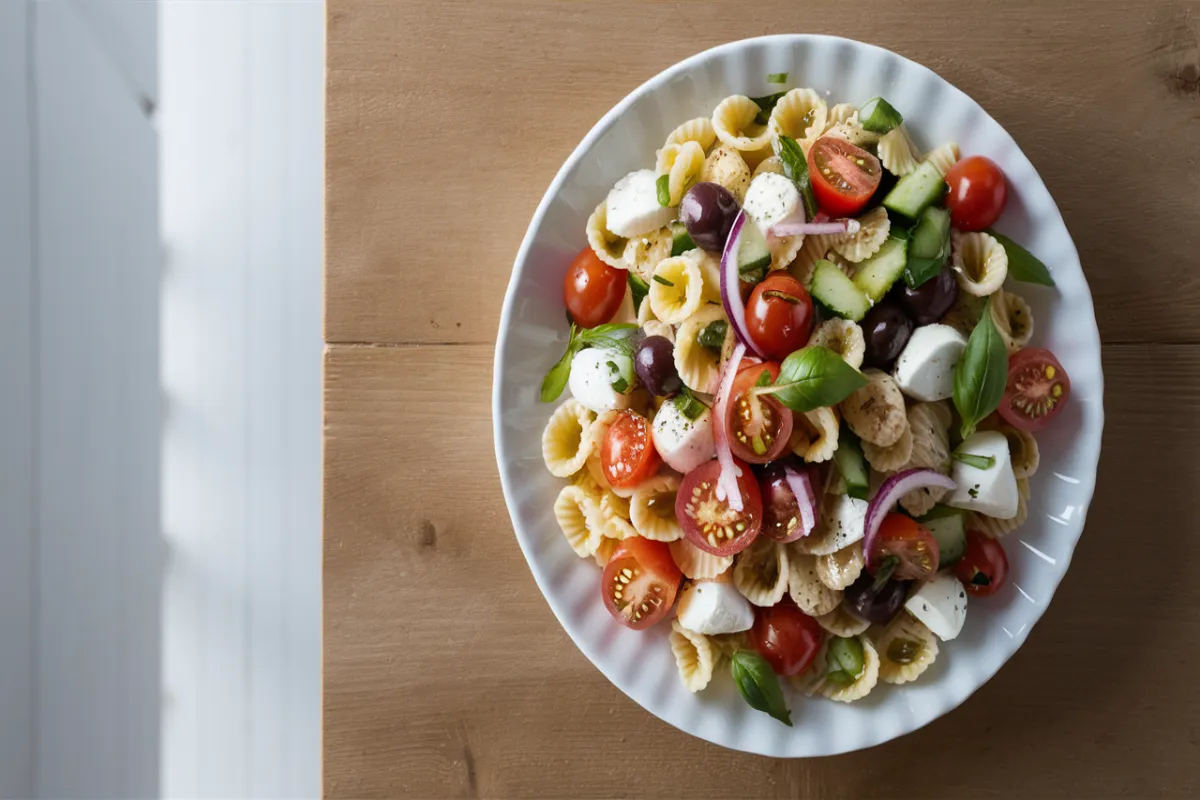Orecchiette pasta salad is a delicious, versatile dish that can be enjoyed year-round, whether you’re planning a summer picnic, a casual lunch, or a light dinner. The unique “little ear” shape of orecchiette pasta makes it perfect for holding onto the flavors and textures of fresh vegetables, herbs, and dressings. In this comprehensive guide, you’ll learn how to make the perfect orecchiette pasta salad, including detailed explanations of each ingredient, step-by-step instructions, tips and tricks for success, pairing suggestions, and answers to frequently asked questions. Whether you’re a seasoned cook or a beginner, this guide will help you create a vibrant and satisfying dish that’s sure to impress.
Ingredients for Orecchiette Pasta Salad

The success of any dish begins with the quality and selection of ingredients. In this section, we’ll explore the key ingredients in orecchiette pasta salad, their roles, and possible substitutions to accommodate different tastes and dietary needs.
1. Orecchiette Pasta (1 pound)
Role:
Orecchiette pasta is the star of this dish. Its unique shape, resembling small ears, is perfect for trapping bits of dressing, vegetables, and other ingredients, ensuring that every bite is full of flavor. The texture of orecchiette is slightly chewy, providing a pleasant contrast to the crunchy vegetables and creamy dressings often used in pasta salads.
Substitutions:
If you can’t find orecchiette, small pasta shapes like shells, farfalle (bow-tie), or rotini can be used as substitutes. However, the texture and ability to hold onto the dressing may vary slightly.
2. Cherry Tomatoes (2 cups, halved)
Role:
Cherry tomatoes add a burst of sweetness and juiciness to the pasta salad. Their bright red color also enhances the visual appeal of the dish, making it more appetizing.
Substitutions:
Grape tomatoes or diced Roma tomatoes can be used if cherry tomatoes are not available. For a slightly different flavor profile, consider using heirloom tomatoes in various colors.
3. Fresh Mozzarella (1 cup, cubed or in small balls)
Role:
Fresh mozzarella provides a creamy, mild contrast to the acidity of the tomatoes and the tanginess of the dressing. It also adds a rich texture to the salad.
Substitutions:
If fresh mozzarella is unavailable, you can use bocconcini, feta, or goat cheese. Each will offer a different flavor and texture, allowing you to customize the salad to your liking.
4. Cucumber (1 large, diced)
Role:
Cucumber adds a refreshing crunch and a subtle, crisp flavor to the salad. Its coolness balances the other ingredients, making the dish more refreshing.
Substitutions:
English cucumber or Persian cucumber can be used as substitutes. If you want a different flavor, try using diced zucchini or bell peppers for added color and crunch.
5. Red Onion (½, thinly sliced)
Role:
Red onion provides a sharp, pungent flavor that cuts through the richness of the other ingredients. It also adds a pop of color and a slight crunch.
Substitutions:
Shallots or green onions can be used if you prefer a milder onion flavor. For a sweeter option, consider using thinly sliced sweet onions.
6. Kalamata Olives (½ cup, pitted and sliced)
Role:
Kalamata olives add a briny, salty flavor that complements the other ingredients. Their dark color also adds visual contrast to the salad.
Substitutions:
Black or green olives can be used as substitutes. If you’re not a fan of olives, you can omit them or replace them with capers for a similar salty bite.
7. Fresh Basil (1 bunch, torn or chopped)
Role:
Fresh basil adds a fragrant, herbal note that brightens the dish. It complements the sweetness of the tomatoes and the creaminess of the mozzarella.
Substitutions:
If fresh basil is unavailable, fresh parsley, mint, or arugula can be used for a different flavor profile. Dried basil can be used in a pinch, but fresh herbs are always preferred for their vibrant flavor.
8. Extra Virgin Olive Oil (¼ cup)
Role:
Olive oil is the base of the dressing, providing a rich, fruity flavor that ties all the ingredients together. It also helps the dressing cling to the pasta and vegetables.
Substitutions:
If you’re looking for a different flavor, you can substitute olive oil with avocado oil or a light vinaigrette. However, the taste will change slightly.
9. Balsamic Vinegar (2 tablespoons)
Role:
Balsamic vinegar adds acidity and tanginess to the dressing, balancing the richness of the cheese and olive oil.
Substitutions:
If you prefer a different vinegar, apple cider vinegar can be used. Lemon juice is also a good alternative for a fresh, citrusy flavor.
10. Dijon Mustard (1 teaspoon)
Role:
Dijon mustard adds depth to the dressing with its sharp, tangy flavor. It also acts as an emulsifier, helping the oil and vinegar blend together smoothly.
Substitutions:
If you don’t have Dijon mustard, whole grain mustard or yellow mustard can be used, though the flavor will be slightly different.
11. Garlic (2 cloves, minced)
Role:
Garlic adds a robust, savory flavor to the dressing, enhancing the overall taste of the salad.
Substitutions:
If fresh garlic is not available, garlic powder can be used. However, fresh garlic offers a more intense and aromatic flavor.
12. Salt and Pepper (to taste)
Role:
Salt and pepper are essential for seasoning the dish, enhancing all the other flavors.
Substitutions:
You can experiment with different types of salt, such as sea salt or Himalayan pink salt, and add other spices like crushed red pepper flakes for a bit of heat.
Step-by-Step Guide to Preparing Orecchiette Pasta Salad
Now that you have all your ingredients ready, it’s time to prepare the orecchiette pasta salad. Follow these steps to ensure your salad turns out perfectly every time.
Step 1: Cook the Orecchiette Pasta
1. Boil Water
Fill a large pot with water and bring it to a boil. Add a generous amount of salt to the water, as this will season the pasta and enhance its flavor.
2. Cook the Orecchiette
Add 1 pound of orecchiette pasta to the boiling water. Stir occasionally to prevent sticking. Cook the pasta until it is al dente, which typically takes 8-10 minutes. The pasta should be tender but still firm to the bite.
3. Drain and Cool
Once the pasta is cooked, drain it in a colander and rinse it under cold water to stop the cooking process. Rinsing also cools the pasta, making it ready to be mixed with the other salad ingredients. Allow the pasta to drain thoroughly to prevent the salad from becoming watery.
Step 2: Prepare the Dressing
1. Combine the Ingredients
In a small bowl, whisk together ¼ cup of extra virgin olive oil, 2 tablespoons of balsamic vinegar, 1 teaspoon of Dijon mustard, and the minced garlic. Season the dressing with salt and pepper to taste. The mustard helps to emulsify the dressing, ensuring that the oil and vinegar combine smoothly.
2. Adjust the Seasoning
Taste the dressing and adjust the seasoning if necessary. You can add more vinegar for extra tanginess or more olive oil for a milder flavor. If you prefer a touch of sweetness, a small amount of honey or sugar can be added to balance the acidity.
Step 3: Assemble the Salad
1. Combine the Ingredients
In a large mixing bowl, combine the cooked and cooled orecchiette pasta, halved cherry tomatoes, cubed fresh mozzarella, diced cucumber, sliced red onion, Kalamata olives, and fresh basil. Toss the ingredients together gently to distribute them evenly throughout the salad.
2. Add the Dressing
Pour the prepared dressing over the pasta and vegetables. Toss the salad gently until everything is well coated with the dressing. The dressing should cling to the pasta and vegetables without pooling at the bottom of the bowl.
3. Let It Marinate
For the best flavor, allow the salad to marinate for at least 30 minutes before serving. This resting time allows the flavors to meld together, making the salad more flavorful.
Step 4: Serve the Orecchiette Pasta Salad

1. Garnish (Optional)
Before serving, you can garnish the salad with additional fresh basil leaves or a sprinkle of grated Parmesan cheese for added flavor and presentation.
2. Serve
Serve the orecchiette pasta salad chilled or at room temperature. It’s perfect as a side dish or as a light main course, especially on warm days.
Tips and Tricks for the Best Orecchiette Pasta Salad
Making a perfect orecchiette pasta salad requires attention to detail and a few helpful tips. Here are some tricks to ensure your salad is delicious and visually appealing:
1. Don’t Overcook the Pasta
Cooking the orecchiette pasta until it’s al dente is crucial. Overcooked pasta will become mushy when mixed with the dressing, losing its shape and texture.
2. Use Fresh Ingredients
The freshness of your ingredients significantly impacts the flavor of the salad. Use fresh, ripe tomatoes, crisp cucumbers, and fragrant basil for the best results.
3. Let the Salad Marinate
Allowing the salad to marinate for at least 30 minutes before serving enhances the flavors. The dressing will have time to infuse the pasta and vegetables, making each bite more flavorful.
4. Serve at the Right Temperature
Orecchiette pasta salad is best served chilled or at room temperature. Avoid serving it straight from the refrigerator, as the flavors are muted when too cold. Let it sit out for a few minutes before serving to allow the ingredients to come to room temperature.
5. Customize to Your Taste
Feel free to customize the salad with additional ingredients like roasted red peppers, artichoke hearts, or grilled chicken. You can also experiment with different herbs and spices to create your own unique version of orecchiette pasta salad.
Pairing Suggestions for Orecchiette Pasta Salad
Orecchiette pasta salad is a versatile dish that pairs well with various sides and main courses. Here are some pairing suggestions to help you create a complete meal:
1. Grilled Chicken
Grilled chicken is a perfect pairing for orecchiette pasta salad, adding protein and a smoky flavor that complements the fresh vegetables and tangy dressing.
2. Garlic Bread
Serve garlic bread alongside the pasta salad for a satisfying meal. The crispy, buttery bread is a great contrast to the chewy pasta and fresh vegetables.
3. Mixed Green Salad
A light mixed green salad with a simple vinaigrette is a refreshing side dish that complements the rich flavors of the pasta salad without overwhelming the palate.
4. Roasted Vegetables
Roasted vegetables, such as zucchini, bell peppers, and eggplant, add depth and warmth to the meal. Their caramelized flavors enhance the freshness of the pasta salad.
5. Fresh Fruit Salad
For a light and refreshing dessert, serve a fresh fruit salad alongside the orecchiette pasta salad. The natural sweetness of the fruit balances the savory flavors of the salad.
Frequently Asked Questions (FAQs)
Q: Can I make orecchiette pasta salad ahead of time?
A: Yes, orecchiette pasta salad can be made ahead of time. In fact, it’s often better the next day after the flavors have had time to meld. Store the salad in an airtight container in the refrigerator for up to three days.
Q: Can I use a different type of pasta for this salad?
A: While orecchiette is ideal for this recipe due to its shape and texture, you can substitute it with other small pasta shapes like shells, farfalle, or rotini.
Q: How do I keep the pasta from getting mushy in the salad?
A: To prevent the pasta from becoming mushy, cook it until al dente and rinse it under cold water to stop the cooking process. Also, be sure to drain the pasta thoroughly before adding it to the salad.
Q: Can I add protein to the orecchiette pasta salad?
A: Absolutely! Grilled chicken, shrimp, or chickpeas make great additions to the salad, turning it into a more substantial meal.
Q: How long can I store leftovers?
A: Leftover orecchiette pasta salad can be stored in the refrigerator for up to three days. Be sure to store it in an airtight container to maintain freshness.
Q: Can I use store-bought dressing?
A: Yes, you can use store-bought dressing if you’re short on time. However, making your own dressing allows you to control the flavors and create a fresher, more vibrant salad.
The Comfort and Versatility of Orecchiette Pasta Salad
Orecchiette pasta salad is a dish that embodies comfort, versatility, and flavor. Its unique shape and texture make it the perfect base for a wide variety of ingredients, allowing you to customize it to suit your taste and dietary preferences. Whether you’re serving it as a side dish at a barbecue, packing it for a picnic, or enjoying it as a light lunch, orecchiette pasta salad is sure to satisfy.
The key to a successful orecchiette pasta salad lies in the quality of the ingredients and the care taken during preparation. By following the tips and tricks provided in this guide, you can create a dish that’s not only delicious but also visually appealing and packed with fresh, vibrant flavors.
From the chewy orecchiette pasta to the juicy tomatoes, creamy mozzarella, and tangy dressing, every bite of this salad offers a delightful mix of textures and tastes. Its adaptability means you can change up the ingredients based on what’s in season or what you have on hand, making it a go-to recipe for any occasion.
So, the next time you’re looking for a dish that’s easy to make, full of flavor, and sure to impress, reach for orecchiette pasta and create a salad that’s as versatile as it is delicious.

